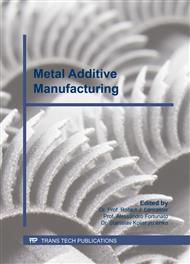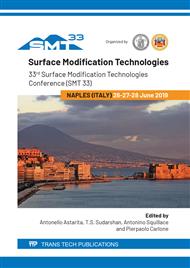p.104
p.110
p.116
p.122
p.129
p.135
p.141
p.147
p.153
Influence of Abrasive Materials in Fluidised Bed Machining of AlSi10Mg Parts Made through Selective Laser Melting Technology
Abstract:
Metal Additive Manufacturing technologies development is increasing in a remarkable way due to their great potential concerning the production of complex parts with tailored characteristics in terms of design, material properties, usage and applications. Among all, the most widespread technologies are the Powder Bed Fusion based technologies such as Selective Laser Melting and Electron Beam Melting. However, the high surface roughness of the as-built parts still represents one of the major limitations, making necessary the adoption of post-process finishing to match the technological requirements for most of the fields of application. In this scenario, Fluidised Bed Machining represents an emerging finishing technology that could overcome some of the limitations of the most common methods, especially in terms of feasibility for the treatment of complex parts thanks to the fluid-like mobility of the abrasive material. This work deals with the preliminary tests of the Fluidised Bed Machining of additive manufactured samples using alumina as the abrasive material, investigating the effects of a high abrasive/substrate hardness ratio condition. The experiments were carried out on small plates of AlSi10Mg alloy made through Selective Laser Melting technology, built in the vertical direction with respect to the building plate. The influence of the impact angle and treatment time were investigated under bubbling fluidization conditions. Surface morphology evaluations were carried out pre and post process by means of Confocal Microscopy and Scanning Electron Microscopy (SEM). Weight loss measurements were conducted to evaluate the material removal rates as well. Results show a small influence of the specific impact angle, a slight reduction of the surface roughness and an asymmetrical effect of treatment, acting mostly on the sintered powders forming the peaks of the as-built surface.
Info:
Periodical:
Pages:
129-134
Citation:
Online since:
July 2019
Price:
Сopyright:
© 2019 Trans Tech Publications Ltd. All Rights Reserved
Share:
Citation:



